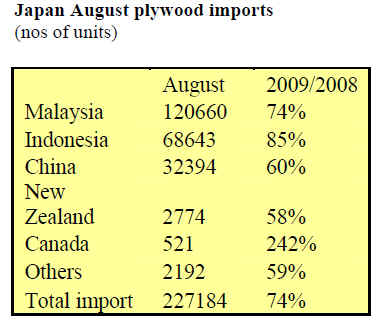Japan Wood Products
Prices
Dollar Exchange Rates of
30th October 2009
Japan Yen 90.79
Reports From Japan
Strong Yen continues
The Yen has been strengthening against the US dollar
since April and at the current rate of Yen 90 per US dollar
it is some 10% up on a year ago. While this is basically
good news for importers it is bad news for exporters.
An additional currency issue facing Japanese importers of
SE Asian logs and plywood over the past months has been
the appreciation of the currencies in the exporting
countries compared to the US dollar.
In February the Indonesian rupiah was as low as 12,000 to
the dollar but it has topped 9,300 recently representing a
22% jump. The Malaysian ringgit is up about 12% from
six months ago.
As most of the business with Japan from the region is
dollar denominated, exporters have been trying to push up
export prices.
To illustrate the effect this is having the Japan Lumber
Reports quotes Indonesian 3x6 concrete formboard at
US$470 per cu.m CIF, up US$20 since September.
Malaysian 3x6 is at US$400-410 per cu.m, US$5-10 up in
a month.
The formboard market in Japan is currently weak so
importers are reluctant to place orders especially as they
see the price increases getting ahead of the Yen/dollar
exchange rates.
August plywood data
Total market supply of plywood in August was
415,000 cu.m some 21% down on the figure for August
last year, as domestic production and imports fell. The
JLR mentions the summer holiday season as affecting
domestic production.
Imports in August fell by 28% year on year with a
continued weakening of the market. Even with the weak
market, there are no signs of wholesale prices easing as
FOB prices continue to firm.
Despite the advantageous Yen/dollar exchange rate,
importers are reluctant to buy because the market in Japan
remains uncertain.

Recovery signs gone
The Japanese plywood market appeared to be on track for
a recovery in August and September due to falling stock
levels but demand is so sluggish that there was no
momentum to drive up prices.
The JLR is reporting that stocks of plywood in Japan are
still well below seasonal norms so prices will remain firm.
Concrete formboard prices are particularly soft with few
enquiries circulating largely because many public works
projects have been put on hold or cancelled by the new
government.
Ultra-thin veneer for plywood
Plywood of 12mm is normally constructed with 5 x 2mm
veneer sheets but a new 12mm panel is on the market and
is constructed with 11 veneers.
Seihoku Corp. has developed the new ply-panel so as to
produce a more stable and stronger product.
The first panels have been constructed with larch and
cedar veneers, testing trials report that the panels give a
good finish and nail holding is above average.
The main disadvantage mentioned by the JLR is the extra
adhesive required which pushes up production costs.
Demand projections
The Japan Forestry Agency has reported its projections for
imports of wood products for the fourth quarter 2009 and
first quarter 2010.
Tropical sawnwood imports are projected at 14,000 cu.m
for the fourth quarter 2009 and projected to drop to
130,000 cu.m in the first quarter of 2010 (respectively
84% and 89% respectively, year on year).
AHEC prepares for Japan
Members of AHEC are preparing to secure certificates to
verify the legality of their supplies to Japanese buyers. At
the moment few Japanese buyers are demanding these
certificates but, as the JLR says, it is only a matter of time
before the industry as a whole takes up the
recommendations of the Japan Forestry Agency (FA) on
this issue.
At a recent AHEC meeting US suppliers to Japan raised
questions with the Forestry Agency representatives. The
JLR is reporting that in response to the question ‘do the
regulations in Japan distinguish between the various
certification systems’ the FA answered, ‘No’.
A second question related to sustainability, ‘does the
regulation in Japan require sustainable yield as a
condition’, again the FA answered, ‘No’. For more on this
see the JLR of 23 October 2009.
Green housing
Japan has a roughly translated ‘carbon dioxide off house’
competition annually. For 2009, Sekisui House Co. Ltd of
Osaka won the prize for the second year running.
To secure the prize the company had “good wood”
procurement guidelines and worked with an NGO to
secure ‘socially fair and environmentally friendly’ wood
products.
The company reportedly had the greatest problem securing
appropriate flooring but eventually found certified wood
flooring products.

|
Abbreviations
| LM Loyale Merchant, a grade of log parcel |
Cu.m
Cubic Metre |
| QS Qualite Superieure |
Koku 0.278 Cu.m or 120BF |
| CI Choix Industriel
|
FFR
French Franc |
| CE
Choix Economique |
SQ
Sawmill Quality |
| CS Choix Supplimentaire |
SSQ
Select Sawmill Quality |
| FOB Free-on-Board |
FAS Sawnwood Grade First and |
| KD Kiln Dry |
Second |
| AD Air Dry |
WBP Water and Boil Proof |
| Boule A Log Sawn Through and Through |
MR
Moisture Resistant |
|
the boards from one log are bundled |
pc per piece |
|
together |
ea
each |
| BB/CC Plywood
grades. Letter(s) on the left indicate face veneer(s), those on the right backing
veneer(s). Veneer grade decreases in order B, BB, C, CC, etc. |
MBF 1000 Board Feet
|
|
Plywood |
MDF Medium
Density Fibreboard |
| BF Board Foot |
F.CFA
CFA Franc
|
| Sq.Ft Square
Foot |
PHND
Pin hole no defect grade |
| Hoppus ton 1.8 cubic metres |
  Price has moved up or down Price has moved up or down |
|
|
|